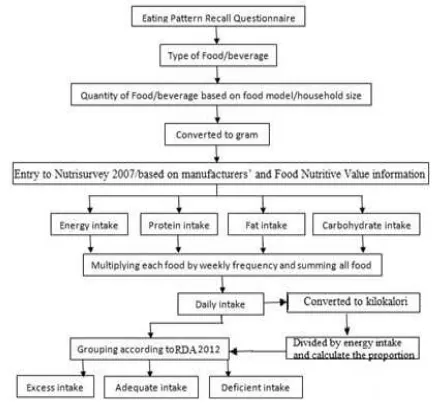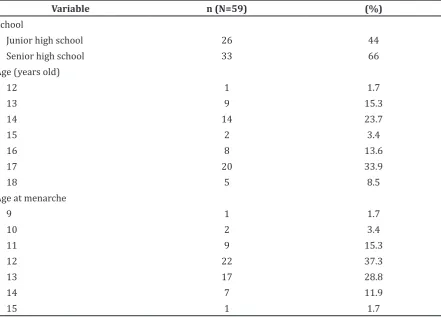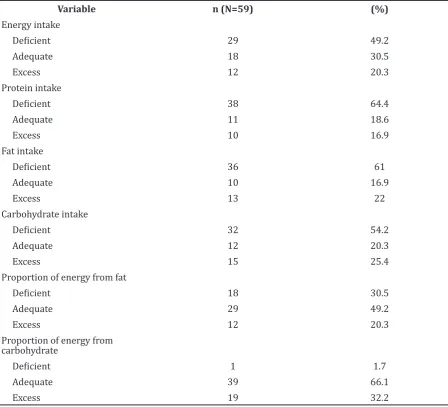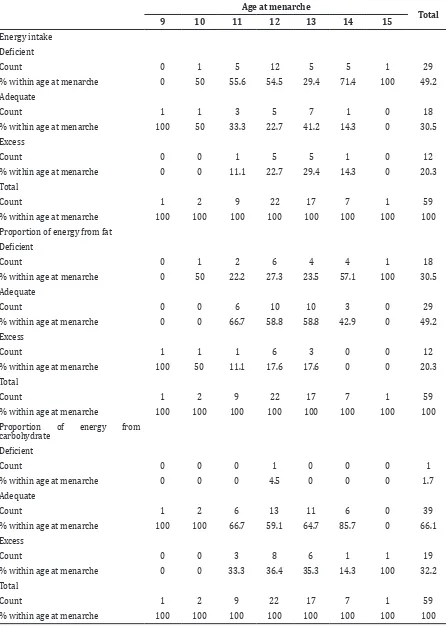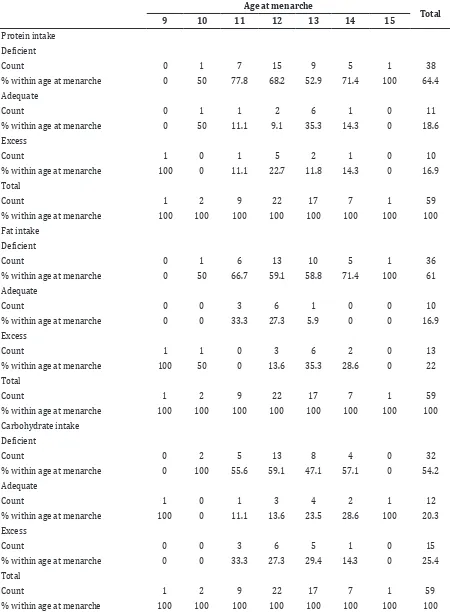Age at Menarche and Eating Pattern among High School Students in
Jatinangor in 2013
Fani Fitrya Nafisah,1 Insi Farisa Desy Arya,2 Eppy Darmadi Achmad3
1Faculty of Medicine Universitas Padjadjaran, 2Department of Public Health Faculty of Medicine
Universitas Padjadjaran, 3Department of Obstetrics and Gynecology Faculty of Medicine
Universitas Padjadjaran/Dr. Hasan Sadikin General Hospital Bandung
Abstract
Background: Age at menarche has notably declined over the past several decades; the fact is in line with the improvement of nutritional intake. Age at menarche can affect health outcomes in adulthood. This study aimed to describe the age at menarche and eating pattern among students in Jatinangor.
Methods: Data were obtained from Survey of Adolescent Reproductive Health in Jatinangor in 2013 with total sampling technique. The sample criteria were data from students who had started their periodwhen the study was conducted. Dietary information was collected by eating pattern recall questionnaire and was taken by trained enumerators. Nutrient intakes and proportion of energy intake were divided into groups according to Recommended Dietary Allowance 2012.
Results: In total, 59 data were analyzed. The age at menarche were ranged from 9 (n=1) to 15 (n=1). Most of students had their menarche at 12 (37.3%). Intake of energy (49.2%), protein (64.4%), fat (61%), and
carbohydrate (54.2%) were mostly deficient, but the proportion of energy intake from fat (49.2%) and
carbohydrate (66.1%) were mostly adequate. The student with youngest age at menarche had adequate energy intake, excess protein intake and excess proportion of energy intake from fat. Student with the oldest
age had deficient energy, fat, and protein intake and excess proportion of energy intake from carbohydrate.
Conclusions: This study shows that student with youngest age at menarche has different eating pattern compared to the oldest, while the others seem similar. [AMJ.2016;3(1):156–63]
Keywords: Eating pattern, Jatinangor, menarche
Correspondence: Fani Fitrya Nafisah, Faculty of Medicine, Universitas Padjadjaran, Jalan Raya Bandung-Sumedang Km.21, Jatinangor, Sumedang, Indonesia, Phone: +62 85294164130 Email: fanifitryanafisah@gmail.com
Introduction
Puberty is the period of sexual function maturation to reach the capability of sexual reproduction. the first menstruation (menarche) occurred at the end of puberty.1
Over the past several decades, age at menarche has notably declined, particularly in western.2
Early age at menarche has been associated with adverse health outcomes in adulthood, including greater body mass index, insulin resistance, metabolic syndrome, breast cancer, cardiovascular disease, and depression, while the later age at menarche has been associated with osteoporosis and increased risk of bone fracture.3-8 National Report on Basis Health Research 20109 reported that 37.5%
Indonesian girls had started their period at 13 to 14, 0.1% at age 6 to 8 years, 19.8% at
15 to 16 years, and 4.5% at older age than 17 years. Another study showed that 0.4% girls in Bandung10 had started their period at 9 and 6.2% at age older than 15 years.
Age at menarche changed in line with the improvement of nutritional intake.2
Consumption of fruits and vegetables were declined, while consumption of foodstuffs from animals were increased. This alteration of eating pattern was allegedly caused by the increasing of vegetable oil availability and due to the advertisement which influence people to consume many products containing sugar.11
by National Report on Basis Health Research, 9 on the contrary the proportion of energy intake from fat and carbohydrate are higher than recommendation of Dietary Guidelines for Indonesian.
Over the past several decades, the economy has improved in Jatinangor. This happens because Jatinangor which was once the plantation area is now the site of several universities. Agricultural land has turned into rental houses for students and shops along the road. Even now there are apartments and shopping malls.14 The changes may affect the
alteration of eating pattern as well as the age at menarche. There were only a few studies were conducted in Jatinangor about age at menarche
and eating pattern. Regarding those issues, this study used data from Survey of Adolescent Reproductive Health in Jatinangor to assess the age at menarche and eating pattern among high school students in Jatinangor.
Methods
Data for this descriptive study was obtained from Survey of Adolescent Reproductive Health in Jatinangor at 2013 which was done by Research Team of Faculty of Medicine, Universitas Padjadjaran. This study was approved by Health Research Ethics Committee. Samples were obtained by stratified cluster random sampling. The first
stage was to choose two schools from Junior High School and two schools from Senior High School in the subdistrict of Jatinangor. The second stage was a randomized method to pick the classes. Data for this study were obtained with total sampling techniques. The inclusion criteria were the data from students who were residents of Jatinangor or at least 2 years in school and had started menstruation when the study was conducted. The exclusion criteria were incomplete data and energy intake was less than 50% from Recommended Dietary Allowance (RDA).
The dietary information used in this study was collected by eating pattern recall questionnaire, comprised of energy, protein, fat, and carbohydrate intake. Data were taken by trained enumerators. The questionnaires included questions about the quantity and type of food which is frequently consumed every week, included meal time, brand name, the process of preparation, composition, weekly frequency, and portions of food and beverage.
Food model was used as the standard portion sizes. Data from the questionnaires were converted to nutrient intake using Nutrisurvey 2007, augmented with manufacturers’ and Food Nutritive Value information. To predict daily mean of nutrient intake, each type of food was multiplied by weekly frequency of consumption and then was summed to all food consumed. Nutrient intakes and proportion of energy intake from fat and carbohydrate were divided into groups according to RDA 2012. The groups for nutrient intakes were deficient intakes (less than 80% of RDA), adequate intakes (between 80−100% of RDA), and excess intakes (greater than 100% RDA). The groups for proportion of energy intake from fat were deficient proportion (less than 25% of total energy), adequate proportion (25−35% of total energy), and excess proportion (higher than 35% of total energy intake). The groups for proportion of energy intake from carbohydrate were deficient proportion (less than 40% of total energy), adequate
Table 1 Characteristic of Subject Based on School, Age and Age at Menarche
Variable n (N=59) (%)
School
Junior high school 26 44
Senior high school 33 66
Age (years old)
12 1 1.7
13 9 15.3
14 14 23.7
15 2 3.4
16 8 13.6
17 20 33.9
18 5 8.5
Age at menarche
9 1 1.7
10 2 3.4
11 9 15.3
12 22 37.3
13 17 28.8
14 7 11.9
proportion (40−60% of total energy), and excess proportion (higher than 60% of total energy intake).15
Results
Not all the sample of Survey of Adolescent Reproductive Health in Jatinangor were taken to this study due to some missing data. In total, 83 eating pattern recall questionnaire were reviewed, 18 questionnaires were excluded due to energy intake less than 50% of RDA and 6 questionnaires were excluded due to incomplete data.
Subjects ranged in age from 12 to 18
years, mostly 17 years (33.9%) with median 16 years. The youngest age at menarche was 9 (n=1) and the oldest was 15 (n=1), mostly were 12 (37.3%). Intake of energy, protein, fat, and carbohydrate was mostly deficient, respectively 49.2%, 64.4%, 61%, and 54.2%, but the proportion of energy from fat and carbohydrate was mostly adequate, respectively 49.2% and 66.1%.
Energy intake of girls who had menarche at 9, was different to the girls who had menarche at 15 (Table 3). The student who had menarche at 9 had adequate energy intake and proportion of energy intake from carbohydrate but proportion of energy intake from fat was excess. The student who had menarche at 15 Table 2 Characteristic of Subject Based on Eating Pattern
Variable n (N=59) (%)
Energy intake
Deficient 29 49.2
Adequate 18 30.5
Excess 12 20.3
Protein intake
Deficient 38 64.4
Adequate 11 18.6
Excess 10 16.9
Fat intake
Deficient 36 61
Adequate 10 16.9
Excess 13 22
Carbohydrate intake
Deficient 32 54.2
Adequate 12 20.3
Excess 15 25.4
Proportion of energy from fat
Deficient 18 30.5
Adequate 29 49.2
Excess 12 20.3
Proportion of energy from carbohydrate
Deficient 1 1.7
Adequate 39 66.1
Table 3 Distribution of Energy Intake and Proportion of Energy from Fat and Carbohydrate Based on Age at Menarche
Age at menarche
Total
9 10 11 12 13 14 15
Energy intake
Deficient
Count 0 1 5 12 5 5 1 29
% within age at menarche 0 50 55.6 54.5 29.4 71.4 100 49.2
Adequate
Count 1 1 3 5 7 1 0 18
% within age at menarche 100 50 33.3 22.7 41.2 14.3 0 30.5
Excess
Count 0 0 1 5 5 1 0 12
% within age at menarche 0 0 11.1 22.7 29.4 14.3 0 20.3
Total
Count 1 2 9 22 17 7 1 59
% within age at menarche 100 100 100 100 100 100 100 100
Proportion of energy from fat
Deficient
Count 0 1 2 6 4 4 1 18
% within age at menarche 0 50 22.2 27.3 23.5 57.1 100 30.5
Adequate
Count 0 0 6 10 10 3 0 29
% within age at menarche 0 0 66.7 58.8 58.8 42.9 0 49.2
Excess
Count 1 1 1 6 3 0 0 12
% within age at menarche 100 50 11.1 17.6 17.6 0 0 20.3
Total
Count 1 2 9 22 17 7 1 59
% within age at menarche 100 100 100 100 100 100 100 100
Proportion of energy from carbohydrate
Deficient
Count 0 0 0 1 0 0 0 1
% within age at menarche 0 0 0 4.5 0 0 0 1.7
Adequate
Count 1 2 6 13 11 6 0 39
% within age at menarche 100 100 66.7 59.1 64.7 85.7 0 66.1
Excess
Count 0 0 3 8 6 1 1 19
% within age at menarche 0 0 33.3 36.4 35.3 14.3 100 32.2
Total
Count 1 2 9 22 17 7 1 59
Table 4 Distribution of Nutrient Intake Based on Age at Menarche
Age at menarche
Total
9 10 11 12 13 14 15
Protein intake
Deficient
Count 0 1 7 15 9 5 1 38
% within age at menarche 0 50 77.8 68.2 52.9 71.4 100 64.4
Adequate
Count 0 1 1 2 6 1 0 11
% within age at menarche 0 50 11.1 9.1 35.3 14.3 0 18.6
Excess
Count 1 0 1 5 2 1 0 10
% within age at menarche 100 0 11.1 22.7 11.8 14.3 0 16.9
Total
Count 1 2 9 22 17 7 1 59
% within age at menarche 100 100 100 100 100 100 100 100
Fat intake
Deficient
Count 0 1 6 13 10 5 1 36
% within age at menarche 0 50 66.7 59.1 58.8 71.4 100 61
Adequate
Count 0 0 3 6 1 0 0 10
% within age at menarche 0 0 33.3 27.3 5.9 0 0 16.9
Excess
Count 1 1 0 3 6 2 0 13
% within age at menarche 100 50 0 13.6 35.3 28.6 0 22
Total
Count 1 2 9 22 17 7 1 59
% within age at menarche 100 100 100 100 100 100 100 100
Carbohydrate intake
Deficient
Count 0 2 5 13 8 4 0 32
% within age at menarche 0 100 55.6 59.1 47.1 57.1 0 54.2
Adequate
Count 1 0 1 3 4 2 1 12
% within age at menarche 100 0 11.1 13.6 23.5 28.6 100 20.3
Excess
Count 0 0 3 6 5 1 0 15
% within age at menarche 0 0 33.3 27.3 29.4 14.3 0 25.4
Total
Count 1 2 9 22 17 7 1 59
had deficient energy intake and proportion of energy intake from fat but the proportion of energy intake from carbohydrate was excess. Students who had menarche at 11 and 12 shows identical pattern, i.e. deficient energy intake (55.6%, 54.5%) with adequate proportion of fat (66.7%, 58,8%) and carbohydrate (66.7%, 59.1%).
Intake of protein and fat in thegirls who had menarche at 9,was excess, conversely girls who had menarche at 15 had deficient intake (Table 4). Carbohydrate intake was adequate for both of them. Girls who had menarche at 11 to 14 mostly had deficient intake of protein, fat, and carbohydrate.
Discussion
Most of the subjects in this study had startedtheir menstruation at 12 (37.3%), the age is earlier compared to age at menarche of Bandung girls (2010) which mostly had started their menstruation at 13 (37%). This difference indicated the possibility role of nutrition and socioeconomic status in age at menarche.10
This study showed that girls in Jatinangor mostly had a deficient nutritional intake. Adequate intake of energy and other nutrients are required for teenagers, such as time of rapid growth and developmental changes at multiple levels, including shifts in fat distribution, increases in height and weight, and emergence of secondary sex characteristics.16 Adolescents who had deficient intake of energy and other nutrients may not achieve optimal growth and development; moreover sub clinical deficits of nutrient may cause impaired immune response.17
Girl with youngest age at menarche had an adequate energy intake with protein intake and proportion of energy intake from fat was excess. These findings are in accordance to the previous study, which suggested that higher fat intake and lower carbohydrate intake associated with accelerated menarche.12
The mechanism of fat in affecting age at menarche is mediated by leptin. Excessive fat intake will be stored in adipose tissue which secrete the leptin. Leptin can affect the reproduction system by triggering the release of Gonadotropin Releasing Hormone (GnRH) from hypothalamus. In response to GnRH secretion, anterior pituitary cells secreting follicle-stimulating hormone (FSH) and luteinizing hormone (LH). The FSH and
LH were circulated through the blood vessels and stimulate the secretion of ovarian steroid hormones.18 In addition the availability of
circulating estrogen may be enhanced by high consumption of fat, thereby influencing pubertal development.12
In the puberty stage, hypothalamic gonadotropin-releasing hormone secretion systems are re-activated and cause an enhancement in amplitude and frequency of GnRH pulses. It increased the gonadotropin circadian rhythms and gonadal steroid secretion. At the final stage of hypothalamic-pituitary development, apositive feedback occurs from the rise of estradiol that cause a midcycle LH surge and then menarche occurs.1,2 Excessive protein intake will increase
the frequency of peak LH and elongation of the follicular phase, so as to accelerate a person to enter the puberty stage; the fact is consistent to the previous studies which suggested that higher protein intake person at 5 to 6 was related to an early age at menarche.13,19
Furthermore high consumption of protein, especially animal protein, stimulates the secretion of insulin and insulin-like growth factor 1 (IGF-1). Then, Insulin and IGF-1 will affect the production of somatopedin, which is an activator of sexual maturity, so as to accelerate a person to enter the puberty stage too.13
Another finding in this study is girls with oldest age at menarche had an excess proportion of energy intake from carbohydrate. The result is consistent to the previous studies which suggested that higher intakes of carbohydrate in girls were associated with the later timing of menarche.12
Eating pattern of adolescence may associate with nutritional knowledge, but there were misconceptions about personal dietary intake levels; in addition, the eating patterns can be affected by innate food preferences, familiarity, and social and environmental influence.17 This
study showed that most girls eat food sold in schools which most of them are fried food and snack containing salt or sugar.
The conclusions of this study are the age at menarche in Jatinangor girls ranged from 9 to 15 and the student with youngest age at menarche had a different eating pattern compared to the oldest, while the others seem similar. Further studies is recommended to determine the relationship between age at menarche and eating pattern by considering other factors such as genetic, body mass index, and physical activity and the impact of early and late menarche need to be observed so further morbidity can be prevented.
References
1. Rebar RW. Puberty. In: Berek JS, editor. Berek & Novak’s gynecology. 14th ed. Philadelphia: Lippincott Williams & Wilkins; 2007. p. 992.
2. Styne D. Puberty. In: Gardner DG, Shoback D, editors. Greenspan’s Basic & Clinical Endocrinology. 8th ed. San Francisco: The McGraw-Hill Companies; 2007. p. 611. 3. Feng Y, Hong X, Wilker E, Li Z, Zhang
W, Jin D, et al. Effects of age at menarche, reproductive years, and menopause on metabolic risk factors for cardiovascular disease. Atherosclerosis. 2008;196(2):590−7.
4. Remsberg KE, Demerath EW, Schubert CM, Cameron WC, Sun SS, Siervogel RM. Early menarche and the development of cardiovascular disease risk factors in adolescent girls: the fels longitudinal study. J Clin Endocrine Metab. 2005;90(5):2178−724.
5. Kaltiala-Heino R, Kosunen E, Rimpela M. Pubertal timing, sexual behaviour and self-reported depression in middle adolescent J Adolescence. 2003;26(5):531−45.
6. Chevalley T, Bonjour JP, Ferrari S, Rizzoli R. Influence of age at menarche on forearm bone microstructure in healthy young women. J Clin Endocrinol Metab. 2008;93(7):2594−601.
7. Chevalley T, Bonjour JP, Ferrari S, Rizzoli R. The influence of pubertal timing on bone mass acquisition: A predtermined trajectory detectable five years before menarche. J Clin Endocrinol Metab. 2009;94(9):3424−31.
8. Yang XR, Sherman ME, Rimm DL, Lissowska J, Brinton LA, Peplonska B, et al. Differences in risk factors for breast cancer molecular subtypes in a population-based study. Cancer Epidemiol Biomararkers
Prev. 2007;16(3):439−43.
9. Badan Penelitian dan Pengembangan Kesehatan Departemen Kesehatan Republik Indonesia. Laporan Nasional Riset Kesehatan Dasar 2010. In: Indonesia DKR, editor. Jakarta: Badan Penelitian dan Pengembangan Kesehatan Departemen Kesehatan Republik Indonesia; 2010. 10. Batubara JRL, Soesanti F, van de Waal HD.
Age at menarche in Indonesian girls: a national survey. Indonesia J Intern Med. 2010;42(2):78−81.
11. Caballero B. The nutrition transition: global trends in diet and disease. In: Shils ME, Shike M, Ross AC, Caballero B, Cousins RJ, editors. Modern Nutrition in Health and Disease. 10th ed. Philadelphia: Lippincott Williams & Wilkins; 2006. p. 1718.
12. Cheng G, Gerlach S, Libuda L, Kranz S, Gunther ALB, Karaolis-Danckert N, et al. Diet quality in childhood is prospectively associated with the timing of puberty but not with body composition at puberty onset. J Nutr. 2010;140:95−102.
13. Gunther ALB, Karaolis-Danckert N, Kroke A, Remer T, Buyken AE. Dietary protein intake throughout childhood is associated with the timing of puberty. J Nutr. 2010;140:565−71.
14. Badan Perencanaan Pembangunan Daerah. Laporan Akhir Studi Kelayakan Kawasan Jatinangor Sebagai Kawasan Perkotaan. Sumedang: Badan Perencanaan Pembangunan Daerah; 2009.
15. Hardinsyah, Riyadi H, Napitupulu V. Kecukupan energi, protein, lemak dan karbohidrat. Widya Karya Nasional Pangan dan Gizi. Jakarta;2012.
16. Treuth MS, Griffin IJ. Adolescence. In: Shils ME, Shike M, Ross AC, Caballero B, Cousins RJ, editors. Modern Nutrition in Health and Disease. 10th ed. Philadelphia: Lippincott Williams & Wilkins; 2006. p. 819.
17. Moreno L, Gonzales-Gross M, Kersting M, Molnar D, de Henauw S, Beghin L, et al. Assessing, understanding and modifying nutritional status, eating habits and physical activity in European adolescents: The HELENA (Healthy Lifestyle in Europe by Nutrition in Adolescence) Study. Public Health Nutr. 2008;11(3):288−99.
19. Susanti AV, Sunarto. Faktor risiko kejadian menarche dini pada remaja di SMP N 30
